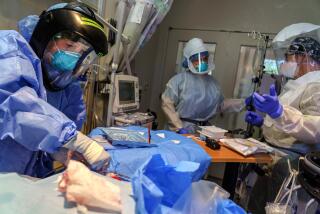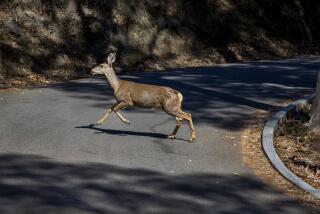Bracing for Life After the Smashup
- Share via
On this date 20 years past, I learned one of life’s most important lessons: Snowmobiles don’t fly.
In April 1984, an intrepid snowmobiler and his pregnant wife happened upon a picture-perfect alpine meadow in central Wyoming, just west of the Continental Divide. The meadow was long with a seemingly gentle slope, oval-shaped, and embraced completely by a recent snow. A cabin beckoned at the far edge, perhaps 1,000 yards away, drawing us like moths to the proverbial flame. Along the outskirts of this pristine white pasture was an obvious path that traced an arc to the same attractive nuisance.
But why travel an oblique route when the object of our attention could be reached so directly? With the impetuosity of youth, I raced straight across the meadow, disdaining the meandering path. Throttle open, full speed ahead, cold clean air in my lungs and adventure ahead, all joy for the moment and not a care in the world.
The impact of face and windshield did little good for the windshield, and even less for the face. This particular meadow was divided in two by a high ledge, obscured from casual view by the snow-blinding beauty of its serene white blanket. Hence the reason for the indirect course of the path not taken. I realized all of this once airborne. At the time, of course, this realization was of limited utility.
Happily for all, the pregnant wife had the smarts not to follow me. Unhappily for her, she had to help maneuver my mangled machine out of a deep ravine and accompany both it and me back to the highway, and then to the hospital. Several hours later, the doctors in Jackson Hole were able to put my nose back in the center of my face (well, mostly), and I lived to tell this tale.
Much has transpired for me in the ensuing 7,300 days. A child was born. He is in college, and in love, full of life, the brightest of futures before him. What would his life be like had my snowmobile flight ended differently? Soon after, another child was born. She graduates from high school in two months, ready to embark upon her own glorious adventure. A tragic snowmobile landing would have withheld vivacity and invigorating complexities from the lives she has touched. (Seeing the daily dose of death in Iraq, I juxtapose my children’s limitless futures with futures torn asunder, lives irretrievably altered by happenstance, the lost contributions of children who will never be born.)
Over the last 20 years I have not spent much time thinking about the matters large and small that might have been affected by one brazen youth living or dying at the end of an unsuccessful snowmobile flight. Life is random. I have been fortunate to experience wonderful things that an unlucky twist of fate, or neck, might have denied me. I cannot honestly say, however, that I have been truly cognizant of that good fortune, or deployed it to great advantage.
Our country is now tumbling into a dark chasm of political bitterness and philosophical argument over issues ranging from war to gay marriage. A polarized populace prepares to choose its leaders, but whatever the outcome, a large, vocal sector of society will be angry and disillusioned. The essential effort to reunite a nation so deeply divided is already one of this century’s great challenges.
Like people, nations are works-in-process, ceaselessly evolving, hopefully for the better. Our country is rapidly approaching its own snowmobile flight. Like mine, it won’t be fatal, but also like mine it will end in an inevitable crash. Because, as I learned 20 years ago, snowmobiles don’t fly. The looming questions are how rapidly might we pull ourselves out of the ravine and how well might we re-center our collective nose and forge a new tomorrow.
That snowmobiles don’t fly is an easy lesson to learn, really. The hard part is divining how best to use that knowledge after the inevitable impact.
More to Read
Sign up for The Wild
We’ll help you find the best places to hike, bike and run, as well as the perfect silent spots for meditation and yoga.
You may occasionally receive promotional content from the Los Angeles Times.






